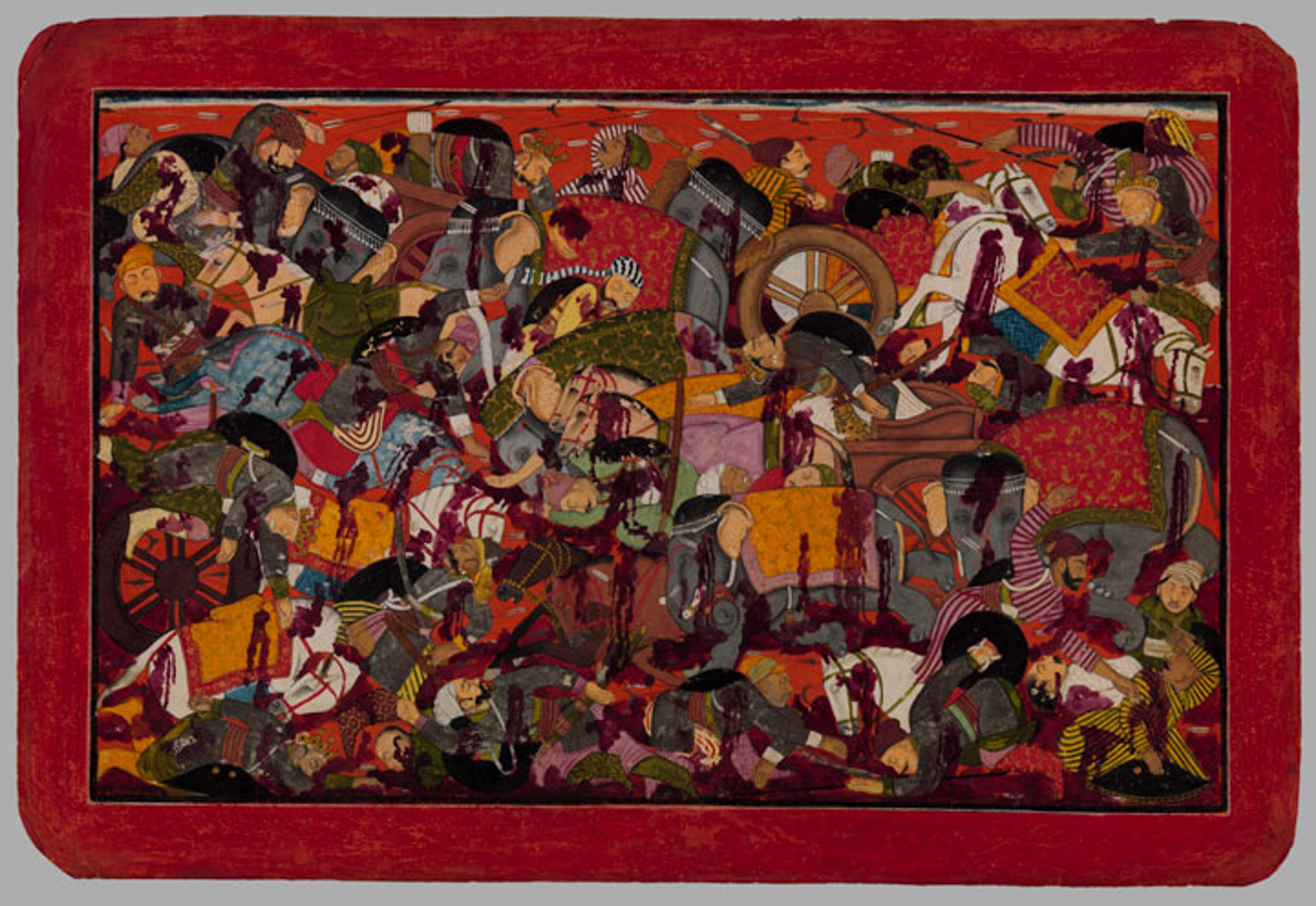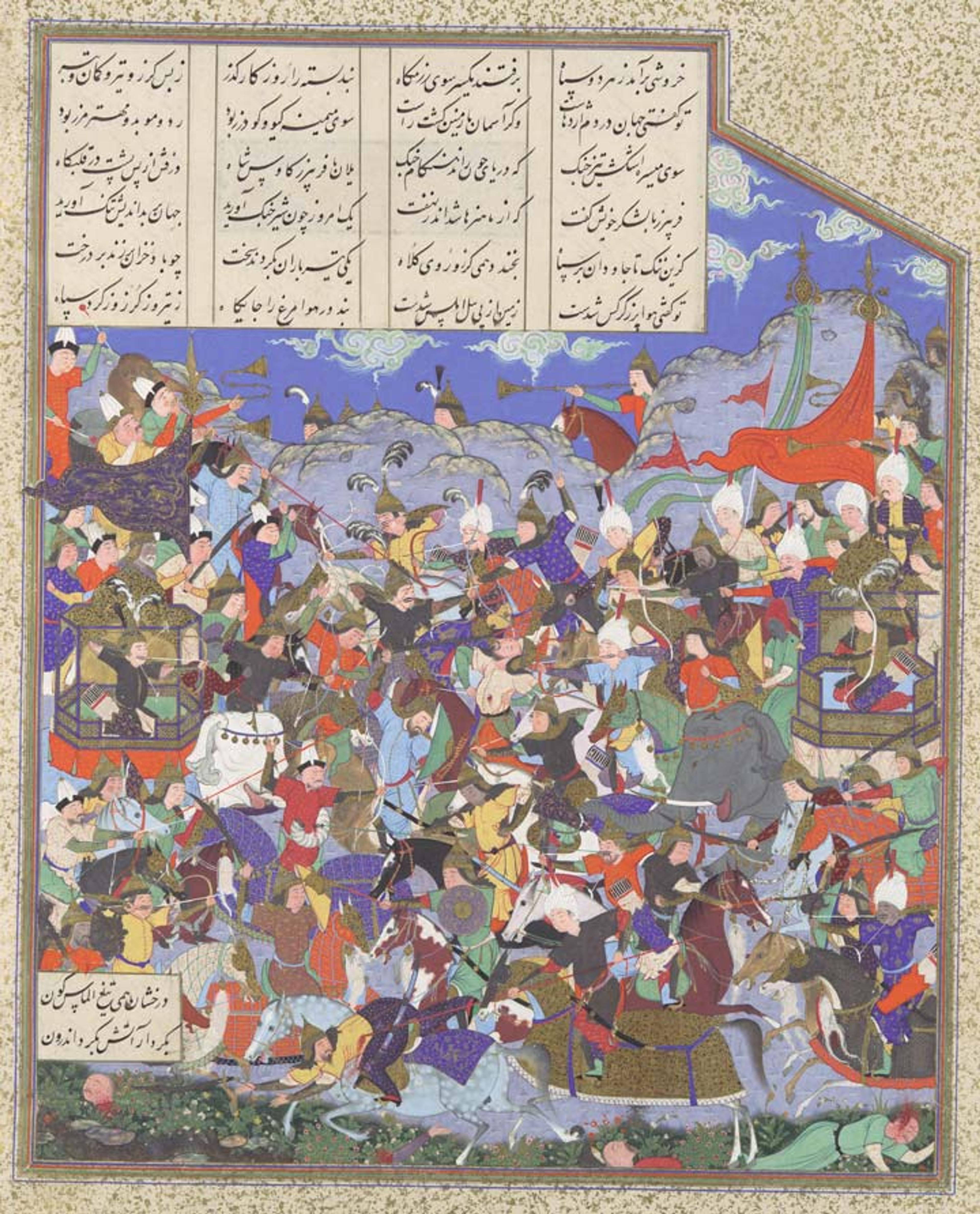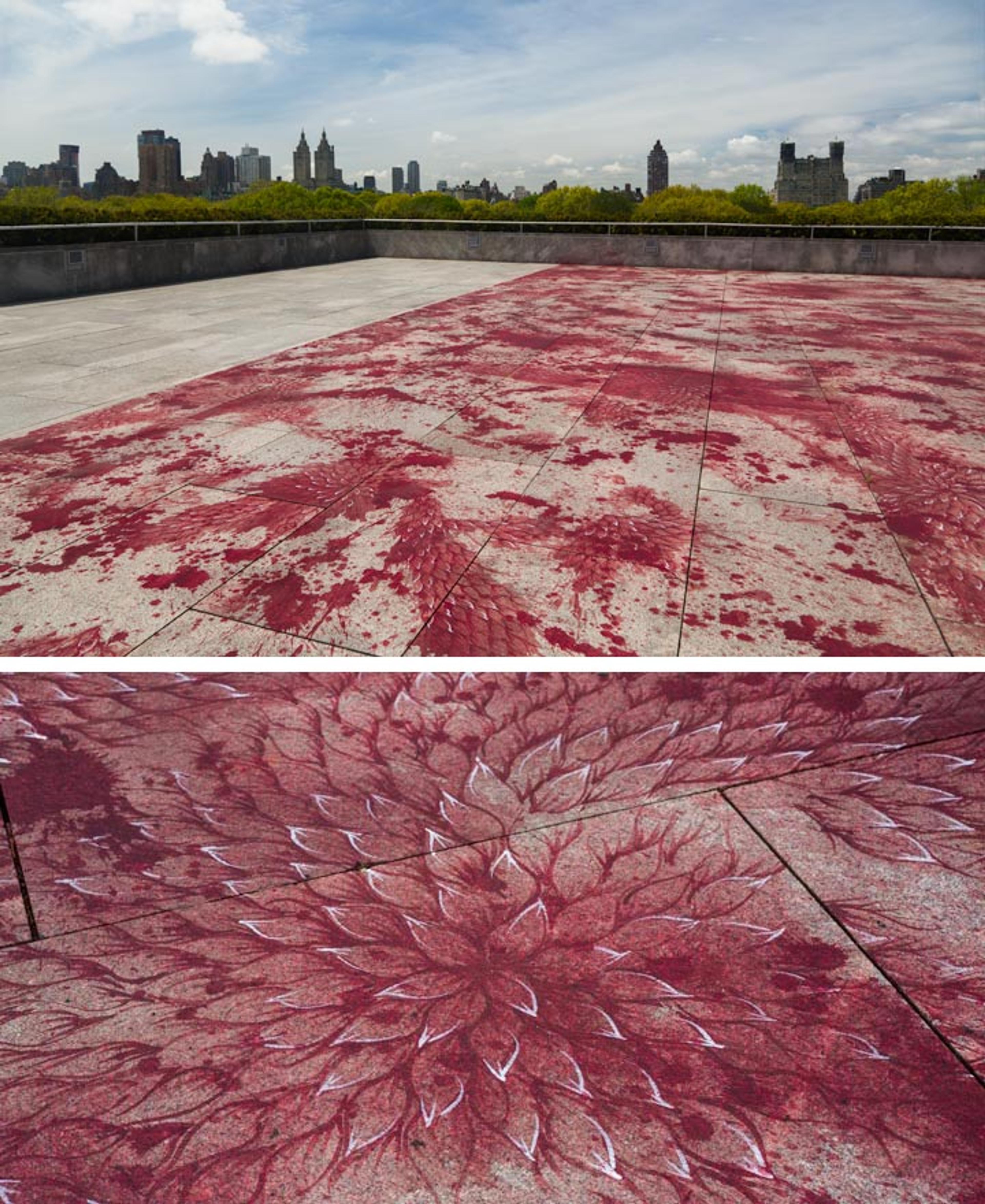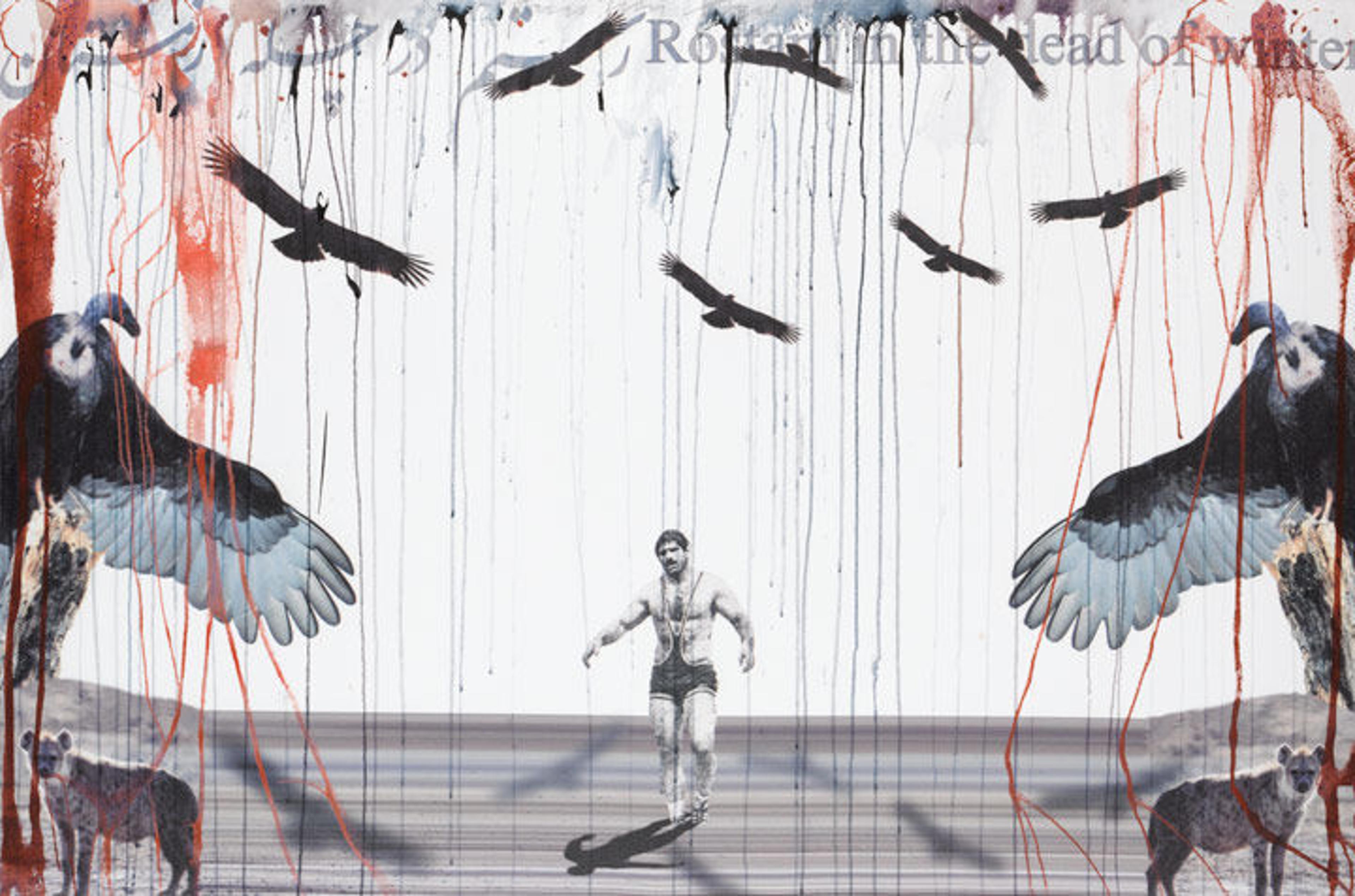Splatters of Blood

Manaku (active ca. 1725–60). "The Nightmare Dream of a King: The Fearsome Aftermath of the Battle of Kurukshetra," Folio from the unfinished "Small Guler" Bhagavata Purana (The Ancient Story of God), ca. 1740. India, Guler, Punjab Hills. Opaque watercolor, gold, and silver on paper; Painting: H. 6 15/16 in. (17.6 cm), W. 11 3/16 in. (28.4 cm). Promised Gift of the Kronos Collections, 2015
«Walking through the exhibition Divine Pleasures: Paintings from India's Rajput Courts—The Kronos Collections, one is surrounded by such richness and beauty—ranging from the tender love paintings of Radha and Krishna to the powerful epic and mythological illustrations from the Ramayana and the Bhagavata Purana (The Ancient Story of God). As someone with little scholarly knowledge of these paintings, I was drawn to one in particular, "The Nightmare Dream of a King: The Fearsome Aftermath of the Battle of Kurukshetra," from the Bhagavata Purana, which depicts a gory war between the Pandavas and the Kauravas.»
I suppose what moved me most was its immediacy: there is a fierce and gruesome battle that Terence McInerney, author of the exhibition's catalogue, describes as a "tangle of victims—the dead and wounded horses, elephants, chariots, and soldiers" with splashes of blood ingeniously splattered throughout the composition. Here the artist, Manaku, does not hold back in depicting the details of the bloodshed and the horror of the scene. The compositional and almost rhythmic effect of the spatters resemble the splashes and drippings of a Jackson Pollock painting.
"The Nightmare Dream of a King" made me think of the treatment of blood in other painting traditions and in a number of works in The Met's collection of modern and contemporary art. There is a distinct difference between the way blood is portrayed in this work from the Punjab Hills of India and how it is shown in a battle scene entitled "The Battle of the Pashans Begins," from the Shahnama of Shah Tahmasp, produced in Safavid Iran.

Abu'l Qasim Firdausi (935–1020); painting attributed to 'Abd al-Vahhab. "The Battle of Pashan Begins," Folio 243v from the Shahnama (Book of Kings) of Shah Tahmasp, ca. 1530–35. Iran, Tabriz. Islamic. Opaque watercolor, ink, silver, and gold on paper; Painting: H. 10 3/4 in. (27.3 cm), W. 9 5/8 in. (24.4 cm). The Metropolitan Museum of Art, New York, Gift of Arthur A. Houghton Jr., 1970 (1970.301.37)
"The Nightmare Dream of a King" draws you into the drama, chaos, and violence, whereas the presence of blood in the Shahnama scene does not elicit the same response. It is cool, detached, and does not come across as particularly disturbing. It embodies an underlying order and energy that produces delight rather than agitation in a viewer. This work draws one's attention to the colors and the details of costume and horse-trappings.
Contemporary artists from South Asia and Iran have also inserted the theme of blood into their compositions. In fact, the Pakistani artist Imran Qureshi, who in 2013 presented an installation entitled And How Many Rains Must Fall before the Stains Are Washed Clean on The Met's Roof Garden, uses blood as a primary motif in his work.

Installation views of The Roof Garden Commission: Imran Qureshi
Qureshi is a master of miniature painting who appropriates Mughal court paintings and drawings of flora and fauna to express the violence and bloodshed he has witnessed in his home country and throughout the world. He splatters red paint over flowers and leaves he has drawn delicately onto street and architectural surfaces. Fusing violence and beauty, he makes a powerful statement at a time when the media bombards us with coverage of violent bombings and carnage almost on a daily basis. In fact, the installation at The Met opened just one month after the Boston Marathon bombings on April 15, 2013.
The artist Fereydoun Ave uses dripping blood in his mixed-media composition Rustam in the Dead of Winter, 2009. In this work he explores the character Rustam, the invincible male hero from the Shahnama who repeatedly triumphs in battle and love. He likens Rustam to a modern-day Iranian wrestler, but instead of portraying him as a glorious hero, he depicts him as a lost soul wandering through a bleak landscape. Ave punctuates the sky above Rustam with dripping blood and vultures, which are suggestive both of death and the ancient Persian and Zoroastrian iconic bird, farvahar. The piece is a meditation on the Iranian male's identity and the dying tradition of chivalry.

Fereydoun Ave (Iranian, born 1945). Rustam in the Dead of Winter, 2009, 2009. Iran. Islamic. Mixed media and print on canvas; Unframed: H. 39 1/8 in. (99.4 cm), W. 58 3/4 in. (149.2 cm), D. 1 7/8 in. (4.8 cm). The Metropolitan Museum of Art, New York, Purchase, 2011 NoRuz at The Met Benefit, 2013 (2013.1142)
In view of recent senseless shootings and violence here in the United States and abroad, "The Nightmare Dream of a King" definitely hits a raw nerve.
Related Links
Divine Pleasures: Painting from India's Rajput Courts—The Kronos Collections, on view at The Met Fifth Avenue through September 12, 2016
RumiNations: Courtney A. Stewart, "The Shahnama in Contemporary Iranian Art" (October 27, 2015)
Maryam Ekhtiar
Maryam Ekhtiar is Patti Cadby Birch Curator in the Department of Islamic Art.